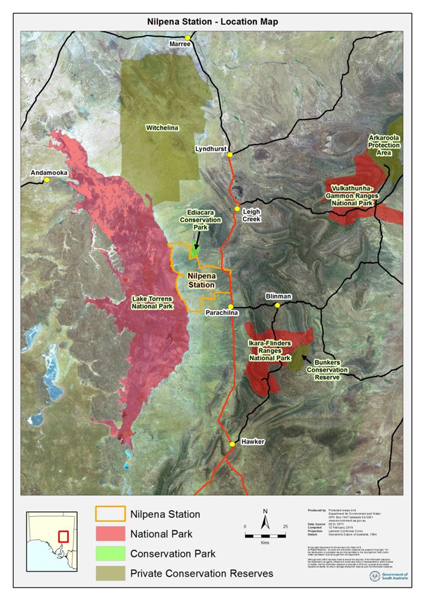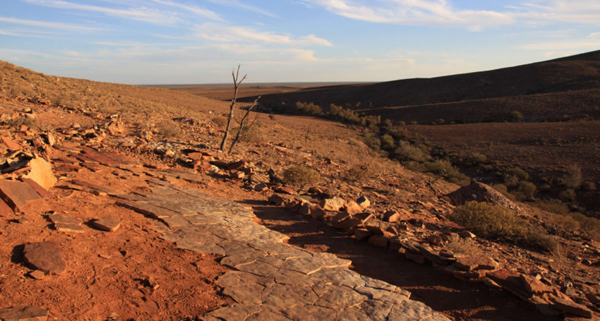South Australian Fossil Site Purchase Supported by Billionaire
With so much bad news about the environment coming out of Australia due to the devastating bush fires, it is pleasing to report on a conservation success story. A $1 billion (USD), nature fund has been used to buy a vast tract of outback South Australia containing some of the oldest animal fossils on Earth. The acquisition safeguards an extremely important fossil site and helps support the Australian Government’s plans to gain World Heritage Site status for the area.
The Nilpena Fossil Fields (South Australia)
Picture credit: Jason Irving
The Unique Ediacara Fossil Site
The 60,000-hectare (150,000 acre) Nilpena West property is 370 miles (600 kilometres), north of the South Australian capital Adelaide and was previously part of Nilpena Pastoral Station. The property includes the Ediacara Fossil Site (Nilpena), which is listed on Australia’s National Heritage List and records a remarkable marine biota, documenting some of the earliest, large, multicellular creatures to have evolved on Earth.
Global not-for-profit organisation The Nature Conservancy, sourced funding from an anonymous donor in October 2019 to allow the purchase and protection to go ahead after the South Australian Government announced in March that it had reached an agreement with the land’s owners to purchase the site. The purchased land is adjacent to the Ediacara Conservation Park and increases the size of the protected area ten-fold.
The Importance of the Flinders Range
Strange fossils, preserved in the sandstone of the Ediacaran hills of South Australia provided the first substantial evidence for the existence of complex life in the late Precambrian. In 1946, Australian geologist Reginald Spriggs discovered fossilised impressions in this part of the Flinders Range, his unexpected discovery failed to enthuse the scientific community at first, his paper outlining the discovery was rejected by the academic journal “Nature”. However, the significance of these exquisitely preserved fossils and what they represented – organisms associated with an ancient marine community, was soon realised.
An Example of Dickinsonia – One of the Fossilised Ediacaran Organisms Associated with the Nilpena Fossil Fields

Picture credit: Dr Alex Liu (Cambridge University)
To read an article about the bizarre Dickinsonia: Dickinsonia Definitely an Animal.
The Wyss Campaign for Nature
The sale has now been finalised with The Nature Conservancy announcing this week that funding from the Wyss Campaign for Nature, the once anonymous donor, had helped secure the acquisition. The Wyss Campaign for Nature was founded two years ago, by the wealthy, Swiss-born philanthropist Hansjörg Wyss. The purchased land will be permanently protected and managed by the South Australian Government. It will be formally allocated to the Ediacara Conservation Park later this year.
A Map Showing the Location of the Nilpena Fossil Fields Relative to the Ediacara Conservation Park

Picture credit: The Government of South Australia
The South Australian property is now permanently protected and managed for conservation by the South Australian Government. It will be added to the Ediacara Conservation Park later this year.
Ediacaran Fossils Represent Scores of Species
Palaeontologists have excavated many hundreds of specimens representing three dozen different species, most of which are more than 550 million years old. The fossils provide the first evidence of locomotion and sexual reproduction. The space agency NASA, has examined the Ediacaran biota in a project to assess how life could evolve on other worlds.
The Nature Conservancy’s Australian Director of Conservation Dr James Fitzsimons explained that this purchase which would permit the formal protection of the 60,000 hectare property was a big win for conservation in South Australia.
He commented:
“The property contains significant biodiversity values including two threatened ecological communities and a number of threatened species. Most critically, the property also covers extremely important sites that contain the oldest fossilised animals on Earth.”
South Australian Environment and Water Minister David Speirs said Nilpena West would soon be added to the South Australian public protected area estate and managed by the Department for Environment and Water.
The minister added:
“Its inclusion in the conservation estate will link the Ediacara Conservation Park to the Lake Torrens National Park and will support our nomination for the listing of areas of the Flinders Ranges as a World Heritage Site.”
When did life on land evolve? An Ediacaran related article: When Did Life on Land First Evolve – Does the Ediacaran Biota Provide the Answer?
A recent article about how computerised tomography and other sophisticated research techniques are providing new insights into how the first animals evolved: Chinese Fossils Suggest Animal-like-embryos Evolved Before Animals.
Everything Dinosaur acknowledges the assistance of a press release from The Lead South Australia in the compilation of this article.
The Everything Dinosaur website: Everything Dinosaur.






Leave A Comment